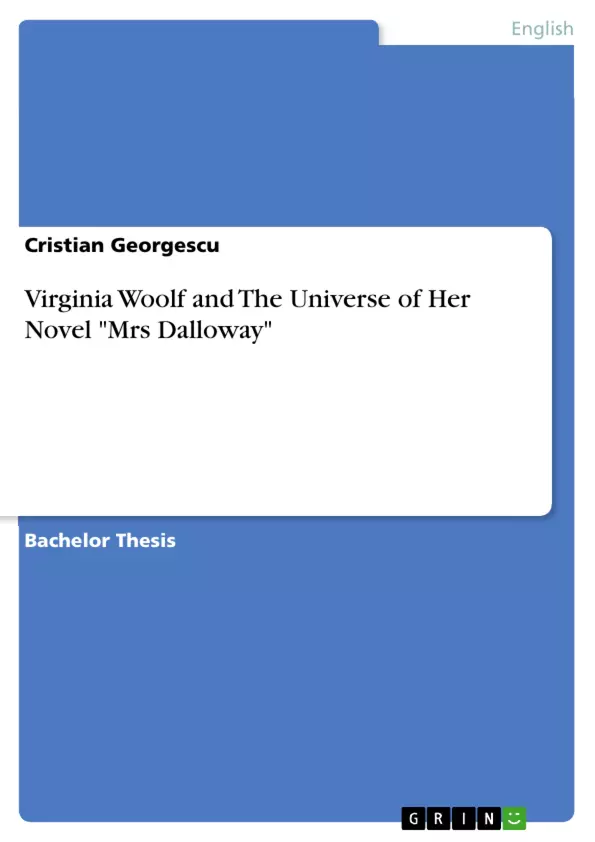The aim of this thesis is to focus on the most important features of the novel that reveal the uniqueness of "Mrs Dalloway" as well as a modern novel as the importance for the development of early twentieth century literature. Therefore, the first part of this thesis deals with the literary and historical context of War and Modernism in the era of Virginia Woolf illuminating the importance of her work, as well as the ambiguous reactions to her writing. In order to understand the genesis of "Mrs Dalloway", the composition and the psychological evolution of the novel will also be discussed. The second part of this thesis concentrates on different topics of the novel concerning style, narrative technique, as well as imagery and characters in order to put together the seemingly dislocated fragments into a clear and clean image of what makes Virginia Woolf’s "Mrs Dalloway" one outstanding example of modern literature.
Table of Contents
- Introduction
- Virginia Woolf's Life and Works
- Literary and Historical Context
- The Era of Virginia Woolf: Bloomsbury, War and Modernism
- The Importance and Contribution of Virginia Woolf's Work
- Critical Reactions and Approaches to Mrs Dalloway
- The Composition and the "psychological" evolution of Mrs Dalloway
- Mrs Dalloway - The Novel
- Virginia Woolf's Style - analysis of a short passage from Mrs Dalloway
- The Stream of Consciousness Technique
- Narrative Control Technique
- Imagery and Symbol in Mrs Dalloway
- Characters in Mrs Dalloway
- From Literary Realism to Literary Modernism in Mrs Dalloway
Objectives and Key Themes
This thesis aims to analyze the key features of Virginia Woolf's novel, "Mrs Dalloway," highlighting its unique qualities as a modern novel and its significance in the development of early 20th-century literature. It explores the novel's connection to the historical and literary context of the era, particularly the impact of World War I and the rise of Modernism.
- The influence of the Bloomsbury Group and the era of Modernism on Virginia Woolf's writing.
- The innovative narrative techniques employed in "Mrs Dalloway," including stream of consciousness and fragmented storytelling.
- The portrayal of post-war London society and its impact on the characters and themes of the novel.
- The exploration of subjective experience and the inner lives of characters through Woolf's unique writing style.
- The critical reception and influence of "Mrs Dalloway" on literary history.
Chapter Summaries
The first chapter provides an introduction to the novel, "Mrs Dalloway," and its place within the broader literary and historical context. It discusses the evolution of the novel form in the 19th century, leading to Virginia Woolf's unique contribution to the genre.
Chapter two delves into the life and works of Virginia Woolf, exploring her upbringing in a prominent literary family and the influence of her early experiences on her writing. The chapter highlights the significance of the Bloomsbury Group and the cultural atmosphere of the early 20th century, particularly the impact of World War I.
Chapter three focuses on the novel itself, analyzing its stylistic innovations and narrative techniques. It examines Woolf's use of stream of consciousness, fragmented storytelling, and the portrayal of subjective experiences.
Chapter four continues the exploration of "Mrs Dalloway," examining its themes, symbolism, and character development. It analyzes the portrayal of post-war London society and the complexities of human relationships.
Keywords
The key terms and concepts explored in this work include: Virginia Woolf, "Mrs Dalloway," Bloomsbury Group, Modernism, stream of consciousness, narrative technique, literary realism, post-war society, character development, symbolism, and critical reception.
- Quote paper
- Cristian Georgescu (Author), 2019, Virginia Woolf and The Universe of Her Novel "Mrs Dalloway", Munich, GRIN Verlag, https://www.grin.com/document/1037257



